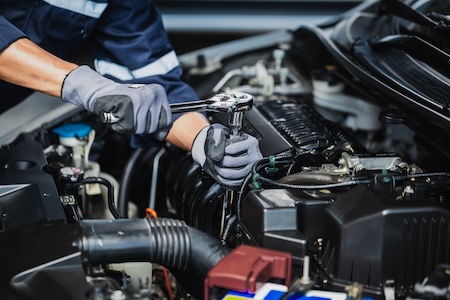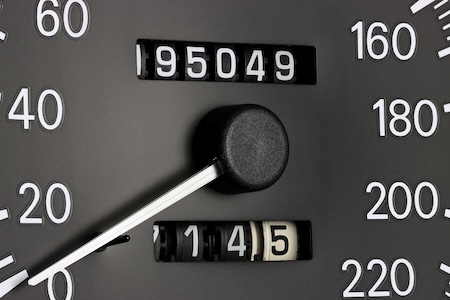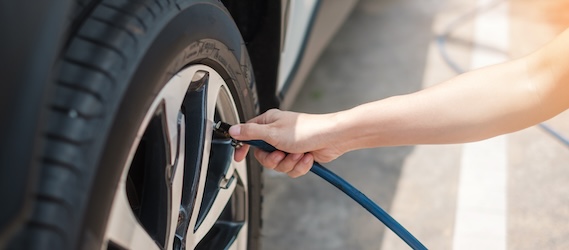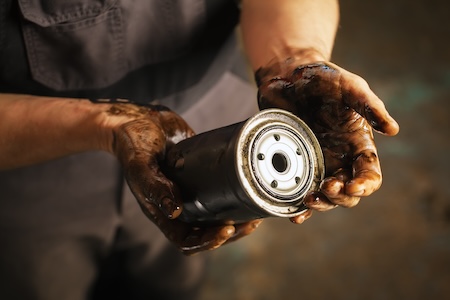You’re pulling into a parking space when it happens—a clicking sound, a groan, or maybe a loud squeal from under your car. You finish the turn, and the noise disappears. So you brush it off.
Until it happens again. And again.
If your car only makes noises when you turn, it’s trying to tell you something. Turning noises are often early warning signs of problems in your steering or suspension system. Left unchecked, those sounds can turn into bigger issues, affecting how your car handles and even putting your safety at risk.
Let’s break down the most common causes of car noises when turning, what each one sounds like, and how to fix them.
What Kind of Noise Is It? Start Here.
Before we dive into causes, take note of what type of noise you’re hearing. This can help your mechanic quickly identify the issue:
- Clicking or popping — Often a CV joint or axle problem
- Groaning or whining — Usually related to the power steering system
- Squealing — Possibly worn belts or low steering fluid
- Clunking or knocking — Could be suspension or steering linkage issues
- Rubbing or scraping — A sign something may be making contact where it shouldn’t
When the noise only happens while turning, the issue is typically linked to components that flex, rotate, or bear weight during directional changes.
Worn CV Joints
CV (constant velocity) joints are part of your front axle. They flex and spin to allow the wheels to turn and move with your suspension.
You may hear a clicking or popping noise, especially during sharp turns or acceleration while turning. A failed CV joint can lead to a complete axle failure, which can cause a loss of control while driving.
CV joints typically need to be replaced when worn. It’s a good idea to check both sides, as they often wear out at the same time.
Low or Leaking Power Steering Fluid
Your power steering system uses hydraulic pressure to make turning easier. Low fluid levels can lead to noise and stiffness when turning.
You’ll often hear a whining or groaning noise, often louder at low speeds or when turning the wheel all the way. Low fluid can damage the power steering pump or rack, leading to expensive repairs or a sudden loss of steering assist.
Check your power steering fluid level and top it off if needed. If it’s leaking, have it inspected ASAP to prevent further damage.
Damaged or Worn Steering Rack
The steering rack connects your steering wheel to your wheels. Over time, especially in vehicles with high mileage, components inside the rack can wear down.
You’ll notice a clunk, knock, or groan when turning, especially while stationary or at low speed. A failing steering rack can affect how your car responds to steering input, making it less precise or harder to control.
The rack may need tightening, repair, or replacement depending on the level of wear.
Worn or Broken Suspension Components
Suspension parts like ball joints, control arms, and tie rods all help manage your car’s weight during turns. If they’re worn or damaged, they may cause noise as weight shifts.
You’ll hear a clunking, creaking, or metal-on-metal sound when turning, especially on uneven surfaces. Suspension issues can affect ride quality, steering response, and tire wear—and may lead to dangerous handling.
Suspension components should be inspected regularly, especially in older vehicles or those driven on rough roads. Worn parts should be replaced promptly.
Loose or Damaged Belts
The serpentine belt drives your power steering pump. If it’s loose, worn, or slipping, it may squeal when the wheel is turned.
You’ll notice a high-pitched squeal when turning or starting the car. If the belt fails completely, your power steering system (along with other vital systems) could stop working.
A belt inspection will tell you if it needs to be tightened, realigned, or replaced. Regular maintenance prevents sudden failures.
Tire Issues
Yes, sometimes the problem is right where the rubber meets the road. Tires that are overinflated, underinflated, or unevenly worn can make noise when turning.
It sounds like a humming or scrubbing noise, especially during tighter turns. Improper tire wear affects traction and fuel efficiency. It also puts strain on your suspension and steering.
Check your tire pressure and tread regularly. Rotate and balance tires every 5,000–7,000 miles to promote even wear.
Wheel Bearing Failure
Wheel bearings help your wheels spin freely while supporting the vehicle’s weight. When they fail, they often create a sound that worsens during turns.
It sounds like a growling or grinding noise that gets louder when turning in one direction. A failed wheel bearing can cause the wheel to wobble or even come off in extreme cases.
Replace worn wheel bearings immediately. Don’t delay—this one’s a safety issue.
Denver Drivers: Pay Attention to Local Conditions
If you live in Denver, your vehicle deals with more than just the occasional pothole. Between elevation changes, winter roads, and temperature extremes, your steering and suspension components work harder than in flatter climates.
Turning through snow-packed streets or maneuvering around tight city parking lots can wear down components faster, especially if your car is older or high-mileage. If you hear a strange noise when turning, don’t assume it’s “just the cold.” Let a professional check it out.
What to Do When You Hear Something Strange
Here’s your action plan:
- Note when it happens. Does the sound occur when turning left? Right? Only while parking?
- Listen closely. What kind of noise is it—clicking, squealing, grinding?
- Check fluid levels. Especially power steering fluid.
- Inspect your tires. Uneven wear or low pressure can mimic more serious issues.
- Schedule a professional inspection. A trusted mechanic can quickly identify and fix the issue before it worsens.
Turn With Confidence—Not Caution
Your car shouldn’t complain every time you steer. If you’re hearing noises when turning, it’s a sign that something needs attention. And the longer you wait, the more expensive the fix might become.
We’re happy to help our customers in diagnosing weird car noises, especially the ones that only show up when you turn. Whether it’s a CV joint, power steering issue, or suspension problem, we’ll get to the root cause and help you fix it fast and affordably.
Hearing a strange sound when you turn? Don’t wait. Give us a call or stop by today.










